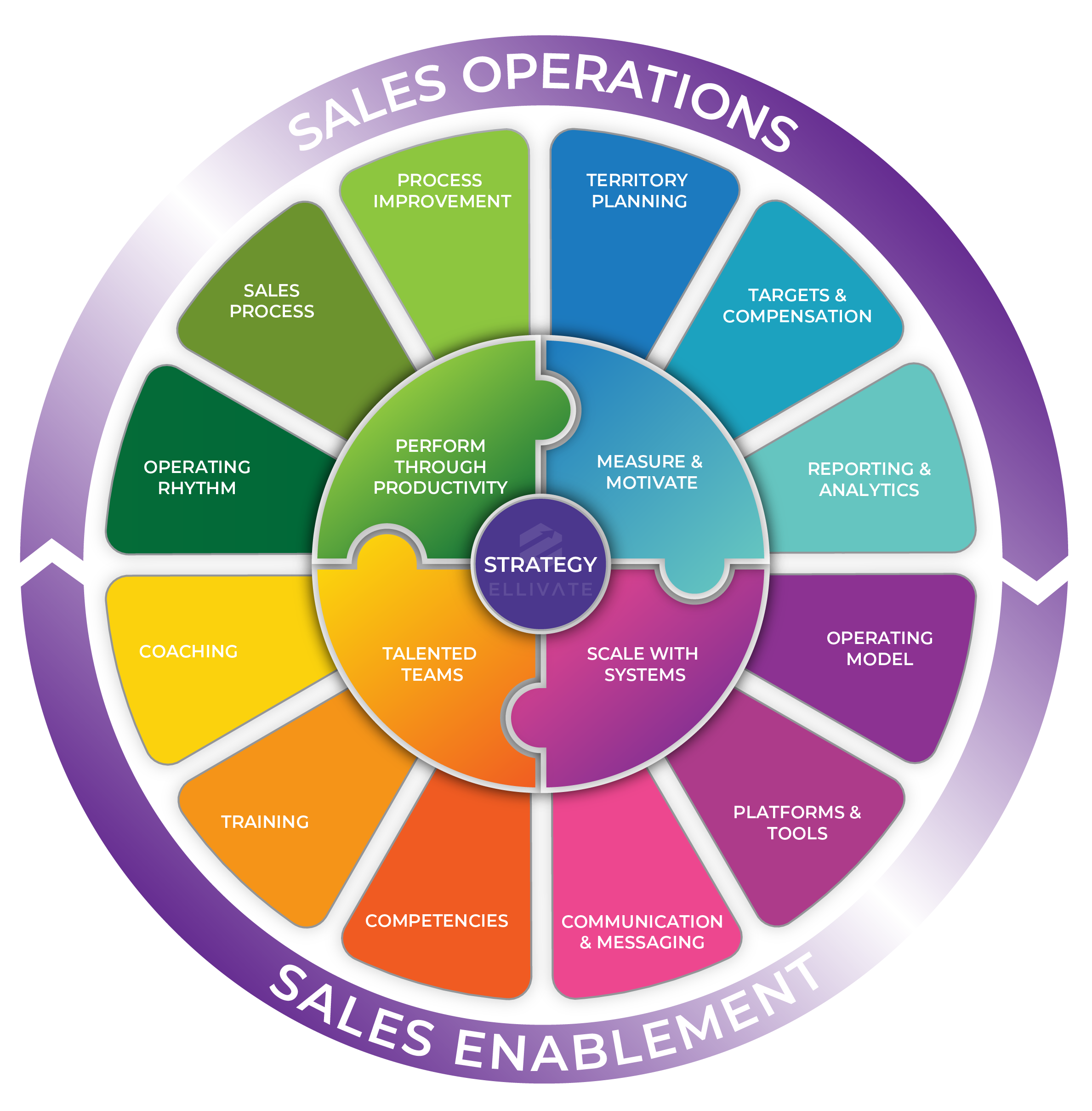Sales operations and sales enablement go hand in hand and quite often the lines can be blurred between what they are and to be honest I don’t think that really matters as long as your organisation sees them as important and has a focus on them early on in the growth journey.
Sales operations is about helping your frontline teams become more efficient in what they do, getting more from less and freeing up their time to spend more time with customers. The average salesperson only spends 35% of their time selling, that’s right just 35% of their time, so what are they doing the rest of their time?
Admin, meetings, updating systems and writing proposals are probably just some of the things that get in their way, but it does not need to be like this, and sales operations can help create a more efficient way of operating.
Sales enablement is about effectiveness and how a salesperson can increase their capability, knowledge and skills to have the best conversations with their prospects and clients. So often organisations hire people from within their industry thinking they will get an immediate return but without the necessary enablement and clarity on how they want them to do things – it can leave them floundering and 10 months later the question being asked is – why they are not performing to expectations? – sound familiar?
I have developed a sales operations and enablement pathway that can be used to establish the necessary systems, frameworks and processes to support your frontline teams in a structured and deliberate way.
At the heart of the pathway is strategy – as every organisation needs a clear strategy that all other activities are supporting the achievement of. This is then supported by the 12 step pathway.

Copyright © 2019 Ellivate Consulting
There are six steps under sales operations focusing on the efficiency of your business:
1. Operating Rhythm.
What are the habits and routines that you want team members to be doing on a daily, weekly, monthly basis? Many people call this ‘cadence’. It should also include internal meetings such as sales huddles, meetings and 121s.
2. Sales Process
What exactly is the sales process that you want people to follow, not just the process when having a conversation with a client but the end-to-end sales funnel that includes marketing when we’re talking lead generation, right the way through to the onboarding of the client and the retention of that client with teams such as customer success.
3. Process Improvement
Think about all the different processes that you should be documenting to help people in frontline teams. What action do you need to take to keep improving those processes and reviewing them to ensure that they are as efficient and effective as they possibly can?
4. Territory Plans
Not having a plan results in what I call the ‘machine gun approach’ where sales reps are firing off calls with no clear plan or strategy whereas you want people on a very targeted and deliberate approach in terms of their account plans. The same goes for service colleagues in having to manage those accounts and having the right amount of focus on the different accounts that they’re looking after.

5. Targets and Compensation
Setting clear goals and outcomes that you require from your people including metrics through the different parts of the sales process. Also, the right reward and recognition systems need to be put in place to motivate and drive performance. So often marketing and service are forgotten here with the focus on sales recognition programs but any approach should include all teams.
6. Reporting and Analytics
What data and insights are you going to provide to your frontline teams to enable them to make better decisions and take more focused actions that are going to generate better outcomes. What reporting are leaders going to use to create accountability and drive performance?
There are six things here that I see as really important under the heading of sales operations and driving the efficiency of both people and the business. Sales enablement also has six steps in the pathway focusing on effectiveness.
7. Operating Model
What structures do you want in place for your customer-facing teams and how they are going to work together to generate the best and most effective working relationships together and create the best customer experience.
8. Platforms and Tools.
There are now over 45 different categories in sales systems and tools and there are over a thousand different sales vendors. Headspin time – that is a lot of complexity to work through to get the best infrastructure for your business. This is why you need to have documented your processes correctly, it’s going to make it a lot more straightforward to pick the tools and the platforms that you want to use for your customer-facing teams to make their jobs easier. So many organisations pick a tool without doing this and then don’t use it to its full potential.

9. Communication and Messaging
This is important both internally and externally. What content are you wanting to get in front of your prospects and your customers from both a marketing and a sales perspective? How do you ensure your messaging is aligned?
How are you going to communicate with those customer-facing teams internally and ensure that you’re creating the most effective outcome so that staff understand the value of your products and services and the pain points that your customers experience?
10. Competencies
What are the skills and competencies that you need in your frontline team members that help support recruitment and onboarding? What are the expectations of them in their roles? Without clearly defined competencies it’s difficult to create accountability for performance or identify gaps in an individual’s skills and capabilities.
11. Training
The competencies you decide on are going to help you develop the training program that will upskill new recruits and bring them up to maturity in their new role, as well as support the ongoing development of team members. Training today needs to leverage technology and can take many different forms but most importantly it needs to be continuous.
12. Coaching
This is critical right the way through sales enablement and sales operations because if leaders are focused on coaching and embedding the learning that their team members are having, they will see significant growth in the individual and the investment in training will pay off.
You can have the best systems and processes in the world but if leaders are not focused on coaching and development of their teams the effectiveness will be limited. So, for me, coaching is one of the most critical parts of the whole framework because we need our leaders to be spending more time coaching and increasing the skills of the frontline team members.
Sales operations and sales enablement is a complex beast and as you can see with my twelve-step pathway it covers all the inner workings of business with frontline sales and service teams. By following this approach and in this order you can set your business up for success and more importantly futureproof the business against issues that form as you scale at pace.

You can download my free eBook which includes tools and framework from my sales operations and enablement pathway – Perform through Productivity.
Chris Ellis is the founder of Ellivate Consulting who focus on providing consulting, training and coaching support in the field of sales operations and enablement for SME’s. Chris has over 20 year’s senior executive experience in the UK, Australia & USA, within financial services and fast-growing technology businesses.
#sales #salesoperations #salesenablement #CRM #operatingrhythm #data #analytics #incentives #salestraining #customersuccess #coaching #competencies #communication #salesprocess #processimprovement #marketing




